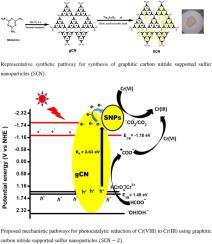Journal of Photochemistry and Photobiology A: Chemistry ( IF 4.3 ) Pub Date : 2020-09-25 , DOI: 10.1016/j.jphotochem.2020.112934 Owolabi M. Bankole , Temitope D. Olorunsola , Adeniyi S. Ogunlaja

|
We report here for the first time a facile strategy for the preparation of graphitic carbon nitride () composited with different weight percentages of sulfur () nanoparticles (), and their remarkable photocatalytic decontamination of toxic hexavalent chromium. Fabrication of the binary hybrid photocatalysts were carried out via two facile steps: conventional thermal polycondensation of melamine into bulk and its delamination, followed by disproportionation of thiosulfate to produce fine dispersed on in the presence of weak organic acids. Absorption intensity of was markedly expanded into visible region after composition with sulfur nanoparticles. Photocatalytic reduction efficiency of by was remarkably higher than bare and the optimum SNPs content on was 8.7 wt% () with photoreduction efficiency of ca. 99 % after 15 min of visible light illumination. Electrochemical characterizations of SNP and samples indicated that the glassy carbon electrode (GCE) modified with enhanced formation of Cr(III) at 65.4 % compared to SNP-modified electrode at ∼36 %. BET results indicated that the presence of sulfur nanoparticles on gCN resulted in higher surface areas (influencing catalytic active sites that improve visible-light absorption), thus, facilitating electron transfer from the conduction band to sulfur species, whilst preventing the electron from recombining with holes. This work opens up the importance of sulfur utilization as promoter for photocatalytic applications.
中文翻译:

石墨氮化碳负载的硫纳米粒子对水中有毒六价铬的光催化净化作用
我们在这里首次报告了制备石墨氮化碳的简便策略()与不同重量百分比的硫()纳米粒子(),以及它们对有毒六价铬的显着光催化净化作用。二元杂化光催化剂的制备通过两个容易的步骤进行:三聚氰胺的常规热缩聚成本体 及其分层,然后硫代硫酸盐歧化产生细粉 分散在 在弱有机酸的存在下。吸收强度用硫纳米粒子组成后,其明显扩展到可见区域。的光催化还原效率 通过 比裸露的要高得多 以及最佳SNP含量 为8.7 wt%()的光还原效率约为 可见光照射15分钟后达到99%。SNP和SNP的电化学表征 样品表明玻璃碳电极(GCE)改性 与约36%的SNP修饰电极相比,Cr(III)的形成增加了65.4%。BET结果表明,gCN中存在硫纳米颗粒会导致表面积增加(影响催化活性位点,从而改善可见光吸收),从而促进电子从导带转移到硫物种,同时防止电子与空穴重组。这项工作打开了硫利用作为光催化应用促进剂的重要性。



























 京公网安备 11010802027423号
京公网安备 11010802027423号